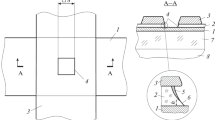Abstract
The physical grounds of electroformation as a process in the self-formation (self-organization) of a nanometer-sized insulating gap in a conducting medium are considered; this process takes place on an open insulator surface when an electric current passes. The proposed physical concepts permit the explanation of all main features of the electroforming process and the properties of electroformed metal-insulator-metal (MIM) structures, such as N-shaped current-voltage characteristics, the bistability, the memory effect, the existence of the threshold voltage of switching from a low- to a high-conducting state, etc. The notations developed allow one to substantially formulate a concept of a new nanoelectronics device—a nano-MIM diode—with an active conducting medium, which may be a base for the nonvolatile electrically reprogrammable memory cell.
Similar content being viewed by others
References
G. Dearnaley, A. M. Stoneham, and D. V. Morgan, “Electrical Phenomena in Amorphous Oxide Films,” Usp. Fiz. Nauk 112, 83–112 (1974) [Rep. Prog. Phys. 33, 1129–1193 (1970)].
H. Pagnia and N. Sotnik, “Bistable Switching in Electroformed Metal-Insulator-Metal Devices,” Phys. Status Solidi A 108, 11–65 (1988).
A. Valiev, V. L. Levin, and V. M. Mordvintsev, “Electroforming as a Self-Organizing Process of a Nanometer Gap in a Carbonaceous Medium,” Zh. Tekh. Fiz. 67(11), 39–44 (1997) [Tech. Phys. 42 (11), 1275–1280].
V. M. Mordvintsev and V. L. Levin, “Conductivity of Nano-MIM Diodes with a Carbonaceous Active Medium in a Model Including Percolation Effects,” Zh. Tekh. Fiz. 69(11), 66–73 (1999) [Tech. Phys. 44 (11), 1322–1329 (1999)].
V. M. Mordvintsev and S. E. Kudrjavtsev, “Highly Doped Si/SiO2/W Sandwich Structures with an Exposed Insulator Edge: Electrical Transport and Electroforming,” Mikroelektronika, 36(6), 1–14 (2007) [Russ. Microelectron. 36 (6), 371–383 (2007)].
A. V. Eletskii and B. M. Smirnov, “Dissociative Attachment of an Electron to a Molecule,” Usp. Fiz. Nauk 147(3), 459–484 (1985) [Sov. Phys. Usp. 28 (11), 956–971].
G. F. Drukarev, Collisions of Electrons with Atoms and Molecules (Nauka, Moscow, 1978; Plenum, New York, 1987).
A. Modinos, Field, Thermoionic, and Secondary Electron Emission Spectroscopy (Plenum, New York, 1984; Nauka (Fizmatlit), Moscow, 1990).
V. M. Gaponenko, “On the Nature of the Formation of Electroformed Channels in Thin-Film MDM Systems,” Izv. Vyssh. Uchebn. Zaved., Fiz., No. 5, 115–120 (1992).
Author information
Authors and Affiliations
Corresponding author
Additional information
Original Russian Text © V.M. Mordvintsev, S.E. Kudryavtsev, V.L. Levin, 2009, published in Rossiiskie nanotekhnologii, 2009, Vol. 4, Nos. 1–2.
Rights and permissions
About this article
Cite this article
Mordvintsev, V.M., Kudryavtsev, S.E. & Levin, V.L. Electroforming as a process in the self-formation of conducting nanostructures for the nonvolatile electrically reprogrammable memory elements. Nanotechnol Russia 4, 121–128 (2009). https://doi.org/10.1134/S1995078009010133
Received:
Published:
Issue Date:
DOI: https://doi.org/10.1134/S1995078009010133




